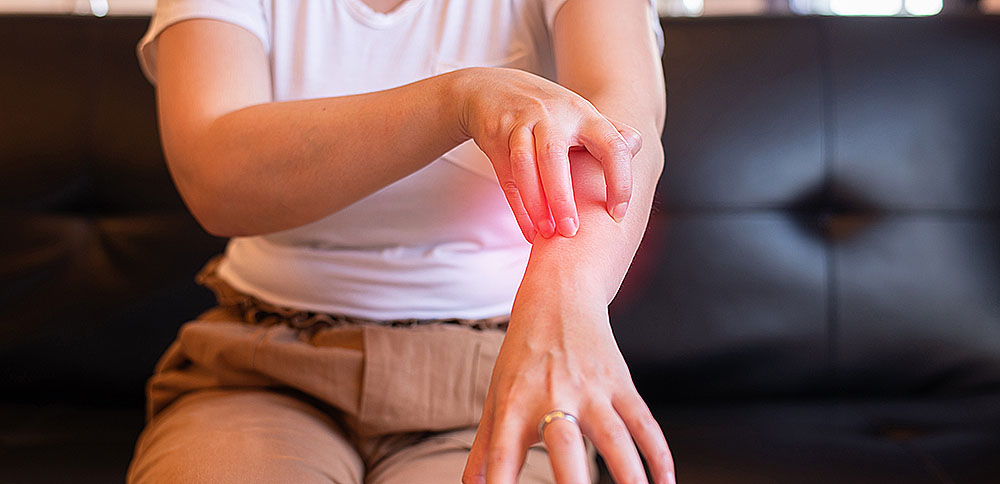It’s summer! But do you know what that means for allergy-sensitive folks? Allergies everywhere! Skin allergies are very common during this time and if you didn’t know this already, there are several different types of skin-related allergies out there. They must be diagnosed by an allergy doctor. Here are all of them.
What Are Skin Allergies?
Skin allergies consist of reactions on the skin that make it break out in red patches, spots, and welts. It normally occurs after being exposed to an allergen and then your skin will immediately turn red. It can also get itchy, raised, and painful.
Skin allergies are very common and they occur in people of almost all age groups. Sometimes, they can occur on their own, and other times, skin allergies can be a direct symptom of another allergy, like hay fever, pollen allergy, pet allergy, food allergy, etc.
Here are the 4 main types of skin allergies:
Eczema
Eczema is a very common skin allergy. It can lead to:
- Dry itchy bumps on the skin
- Flakiness of the skin
- Patches that appear mostly on the inside of the arms, knees, armpits, back, and chest
- Too much itching can make the skin sore and it can break out into an infectious wound
Causes:
- Eczema can occur in children and adults alike and it can be because of either allergic sensitivity or it can be genetic.
- Eczema is also caused by overuse of chemical lotions and creams on the body and it can also be due to fragrance and colors in different soaps, lotions, and other topical creams that people use on an everyday basis.
- Eczema can also be a symptom of other allergic or hereditary diseases, like asthma and hay fever.
People with eczema need to switch to products that are suitable for their extremely sensitive skin. So, anything with no fragrance, no color, and minimal ingredients will work for eczema patients. If you want to go down the traditional route, then indulgent oatmeal baths can help to alleviate the dry skin and the natural oils and milk of oatmeal can help soothe the skin and get rid of the patches for good.
Contact Dermatitis
Contact dermatitis is the most common type of skin allergy to occur. Any allergen that comes directly in contact with the skin and causes irritation, formation of red patches, and itchiness is known as contact dermatitis. There are 2 types of contact dermatitis:
- Irritant contact dermatitis is a type of skin condition that’s caused by the direct touching of the allergen or trigger with the skin.
- Allergic contact dermatitis is a type of allergic reaction on the skin that’s caused when the immune system is compromised and attacked by foreign bodies that find their way inside the skin, mouth, nose, or ears.
Regardless, the symptoms of contact dermatitis include:
- Dry skin
- Formation of red patches
- Itchiness like crazy
- Bleeding, if you itch it too much
To treat contact dermatitis, you need to stop exposure to the allergen immediately. Allergic contact dermatitis can be treated if the allergen exposure is limited. As far as medicinal treatment is concerned, antihistamines and topical creams work best. Antihistamines stop any internal inflammation of the skin and also relieve the itchy sensation, so you’ll feel better in no time at all.
Hives
Hives, also known as urticaria, is a condition of the skin that starts as an itchy red patch but turns into swollen red welts. When you try to press on it, the welt can get white and as soon as the pressure is relieved, the whiteness turns back to red. Hives is a main symptom of hay fever or allergic rhinitis and it can cause the skin to be itchy, to the point where you want to keep going at your skin until it bleeds.
Hives usually occur on the areas of the body that are folded, like the upper part of the neck, inside of the arms, and behind the legs.
Hives can be treated easily by:
- Using topical itch-relieving creams
- Avoiding the allergen, including hay, dust, and insects
- Taking antihistamines to deal with the inflammation of the skin
Hives can be of two types:
- Chronic hives keeps on occurring after a specific period of time and it’s associated with anxiety, autoimmune disorders, and other diseases.
- Acute hives occurs once and has a lasting period of about 6 days before it starts to diminish. It’s usually aggravated by contact with an allergen like pollen, pet hair, etc.
Angioedema
Angioedema is essentially swelling or water retention underneath the first layer of skin. This swelling can occur on:
- The lips
- The eyes
- The cheeks and overall face
It is the main indicator of any allergy because as soon as the allergen comes in contact with the skin, it can get inflamed and swollen to a great degree. However, angioedema can get better after a day or two and the swelling starts to go down naturally, even if you haven’t used anything to alleviate it.
Here are some things that you can do to reduce swelling on the face:
- You can try out hot and cold compress to alleviate swelling on the face, as the temperature will help to get rid of the swelling.
- You can also take antihistamines to combat any internal swelling or inflammation and it will also help with the redness.
Angioedema doesn’t usually cause redness, but sometimes a tinge of color is imparted on the skin where the swelling is. Depending on the area, the swelling can also be painful at times and it goes away as the swelling subsides, so it might be a tad bit uncomfortable. However, if the swelling is severe or painful, visit an allergy center.
Triggers Of Skin Allergies
Skin allergies are caused by triggers. Here are some common triggers that humans are exposed to:
Skincare Products
A lot of the time, skincare products have base products like parabens, active ingredients, etc., that can cause the skin to break out in itchy red bumps. Things like retinol, vitamin C, and other actives should be used carefully.
Jewelry
Jewelry is made out of many different kinds of metals and the pieces are in direct contact with the skin, so naturally some metals can also lead to allergic reactions on the skin. Nickel, silver, and a mix of other jewelry-making metals can cause the skin to get irritated.
Sun Exposure
The Sun isn’t as big of a culprit of skin allergies as are UV rays. UV rays penetrate the skin, darken it, and make it prematurely wrinkled. This is why people with sensitive skin are advised to always wear sunscreen whenever they go out to avoid allergic reactions on the skin.
Other Triggers
Other than the obvious, skin allergy triggers can also include pet fur, certain foods like wheat, gluten, nuts, seeds, and dairy, and natural triggers like dust and pollen. These triggers, known as allergens, can also cause severe and detrimental reactions on the skin.
Conclusion
Skin allergies can be a pain in the neck, especially when you don’t know which is which and have to find your way around a treatment. Well, this guide will help you through. However, you must visit an allergy specialist if you see rashes, welts, or swelling on any part of your body.


